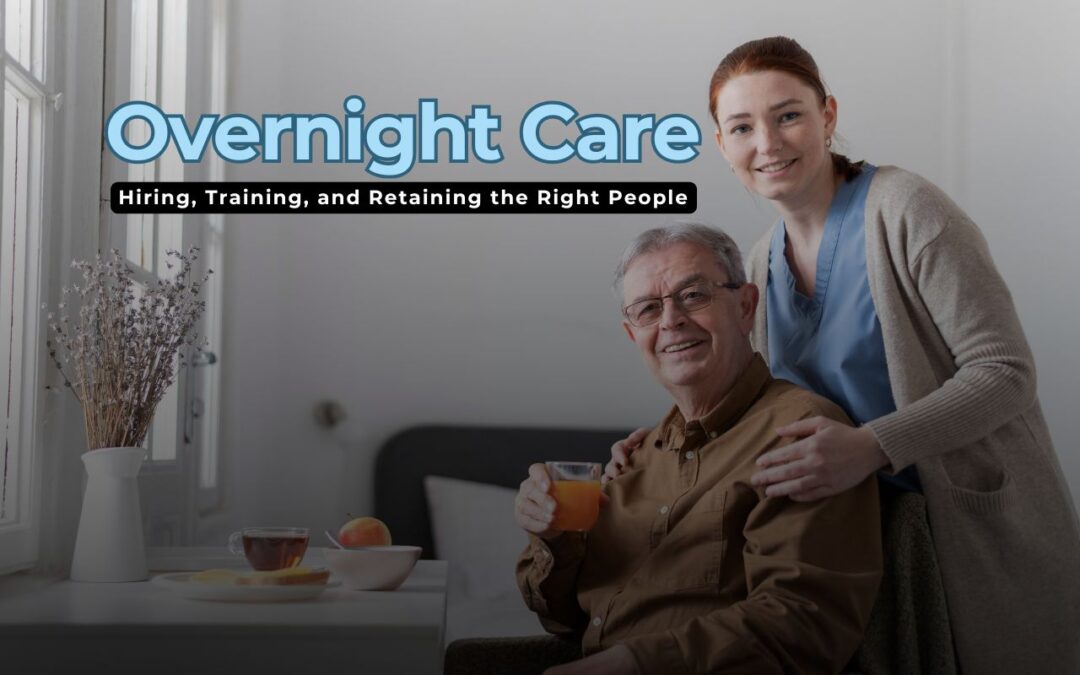In the quiet hours of the night, care doesn’t stop—and neither should your commitment to quality staffing. Whether in assisted living communities, hospitals, home healthcare settings, or group homes, overnight care is essential to ensure the safety, comfort, and dignity of individuals who require support 24/7.
Staffing for the night shift comes with a distinct set of challenges: limited visibility from management, lower social interaction, higher rates of fatigue, and more autonomy. The people who step into these roles must be uniquely prepared—not only to manage routine responsibilities but also to respond to emergencies with calm confidence and compassion.
In this guide, we’ll explore best practices for hiring, training, and retaining overnight staff—covering everything from recruitment techniques to burnout prevention strategies. Our goal is to help care organizations build resilient, high-performing night teams that deliver exceptional care when it matters most.
Section 1: Understanding the Unique Demands of Overnight Care
What Makes Overnight Staffing Different?
Night shifts typically run from around 10 p.m. to 6 or 7 a.m., but exact hours vary depending on the setting. Unlike daytime shifts, overnight caregivers often work in a quieter, more autonomous environment. They’re responsible for everything from monitoring sleeping residents to handling late-night medical issues, managing documentation, and preparing for morning routines.
The unique demands include:
- Limited supervision and support: Fewer staff and managers are on duty.
- High responsibility: Staff may be the only point of contact for multiple clients or residents.
- Increased risk of fatigue and alertness errors: The circadian rhythm is naturally at its lowest during the night.
- Emotional labor: Staff may deal with loneliness, confusion, or anxiety from patients.
Understanding these factors helps set the foundation for better recruitment, onboarding, and support strategies.
Section 2: Hiring for Overnight Care—What to Look For
Hiring the right individuals is the first step toward delivering dependable overnight care. But it’s not just about filling a time slot—it’s about finding people who are mentally, emotionally, and physically prepared for night work.
Key Qualities of a Great Overnight Caregiver
- Self-Motivation: Night staff often work independently with minimal supervision.
- Attention to Detail: Mistakes at night—when fewer people are around—can have serious consequences.
- Strong Communication Skills: They must document incidents clearly and communicate handoffs effectively.
- Emotional Intelligence: They need to soothe distressed residents, manage behavioral issues, and remain calm under pressure.
- Adaptability: Emergencies don’t operate on a schedule. A good night shift worker must respond flexibly and think on their feet.
Interview Questions That Matter
Here are some sample interview questions that dig into the mindset and skills needed for overnight care:
- “How do you stay alert and focused during a night shift?”
- “Tell me about a time when you had to make a quick decision without direct supervision.”
- “Describe how you would handle a resident who becomes confused or agitated at 3 a.m.”
- “Have you experienced working alone at night? How do you manage loneliness or isolation?”
Look for thoughtful, practical answers that reflect real experience and self-awareness.
Section 3: Background Checks and Due Diligence
Trust and safety are paramount in overnight care. Because overnight staff often work unsupervised or have access to sleeping clients, thorough screening is non-negotiable.
Components of a Comprehensive Background Check
- Criminal Background Checks:
- Include both local and federal records.
- Screen for violent offenses, theft, elder abuse, or past drug offenses relevant to the job.
- Include both local and federal records.
- Employment and Reference Verification:
- Don’t skip this step. Speak directly to former supervisors.
- Ask specific questions: “Would you rehire this person for a night shift care position?”
- Don’t skip this step. Speak directly to former supervisors.
- Drug Screening:
- Especially critical for roles requiring alertness and responsibility.
- Consider periodic re-screening.
- Especially critical for roles requiring alertness and responsibility.
- Credential and License Verification:
- Ensure certifications (e.g., CNA, HHA, LPN, RN) are valid and current.
- Confirm that mandatory training hours and continuing education requirements are met.
- Ensure certifications (e.g., CNA, HHA, LPN, RN) are valid and current.
- Driving Record Checks:
- For home health aides or staff using company vehicles during night calls.
- For home health aides or staff using company vehicles during night calls.
- Elder Abuse Registry Checks (where applicable):
- Some states maintain databases of individuals barred from working in elder care settings.
- Some states maintain databases of individuals barred from working in elder care settings.
Red Flags to Watch For
- Gaps in employment that the candidate cannot explain
- Frequent job changes, especially in similar roles
- Vague or unverifiable references
- Evasive answers during interviews about overnight experience
Section 4: Effective Onboarding and Training for Night Staff
Once you’ve hired the right people, the next step is equipping them to succeed.
Create a Tailored Night-Shift Onboarding Program
Many organizations use a one-size-fits-all onboarding approach. Instead, tailor your onboarding for overnight roles by including:
- Night-specific procedures (e.g., emergency response, medication administration at night)
- Facility walkthroughs during nighttime hours
- Communication protocols between night and day staff
- Shadowing with experienced overnight employees
Scenario-Based Training
Use simulations and role-playing to train night staff for real-life situations such as:
- A resident wandering due to sundowning
- A power outage or medical emergency
- Handling alarms or security incidents
Documentation Training
Documentation during the night is critical, especially for handoffs to morning staff. Train employees to:
- Write accurate, timestamped reports
- Use digital systems correctly
- Report unusual behavior or patterns
Empower Staff with Autonomy
Because night staff often work alone, empower them with:
- Clear guidelines on when to escalate situations
- Direct lines of communication to on-call supervisors
- Access to support resources (e.g., emergency procedures, mental health contacts)
Section 5: Preventing Burnout and Promoting Retention
Night shift burnout is a real issue. Sleep deprivation, isolation, and lack of recognition contribute to high turnover. The good news? Burnout is preventable with the right approach.
Strategies to Reduce Burnout
1. Shift Consistency
- Avoid flipping schedules or rotating shifts often.
- Consistent night schedules allow workers to establish a stable sleep pattern.
2. Adequate Rest Time
- Prevent excessive back-to-back shifts.
- Offer extended time off after multiple consecutive overnights.
3. Provide Mental Health Support
- Offer access to confidential counseling services.
- Check in regularly with supervisors who are trained to spot signs of stress or burnout.
4. Nutrition and Physical Support
- Offer healthy snacks, hydration, and access to microwaves or fridges.
- Encourage staff to take scheduled breaks and stretch or walk during long shifts.
Section 6: Retaining and Motivating Your Night Staff
Recognition Goes a Long Way
Overnight workers often feel invisible. Acknowledge their efforts by:
- Featuring them in newsletters or team meetings
- Hosting appreciation events specifically for night teams
- Writing personalized thank-you notes or giving small tokens of appreciation
Offer Professional Development
Show your overnight team there’s a growth path by:
- Offering paid certifications or continuing education courses
- Promoting from within—make night staff eligible for team lead roles
- Providing access to training during daytime hours via recorded sessions or digital modules
Build a Sense of Community
Encourage connection across shifts:
- Use group chats or communication apps to share updates and foster belonging
- Rotate in daytime managers for occasional overnight visits to show support
- Involve night shift staff in organizational planning and decisions
Section 7: Creating a Culture That Supports Overnight Teams
Ultimately, a healthy overnight care environment depends on your organization’s culture. If you value your night staff, your clients and residents will feel that care.
Policies That Make a Difference
- Night Shift Differential Pay: Acknowledge the challenge of working overnight with increased pay.
- Fair Scheduling Practices: Give night workers a say in their schedules where possible.
- Health and Wellness Programs: Tailor wellness offerings for those who sleep during the day.
- Transparent Communication: Keep night staff in the loop on policy changes, client updates, and organizational news.
Section 8: Real-World Examples of Night-Shift Success
Here are two brief case studies to inspire your overnight care staffing strategy:
Case Study 1: Assisted Living Community in Oregon
Challenge: High turnover on the night shift and increased fall incidents among residents.
Solution: The community created a structured onboarding program, paired new hires with “Night Mentors,” and introduced a bonus program for quarterly attendance.
Result: Within six months, turnover dropped by 40%, and fall incidents during night hours decreased by 30%.
Case Study 2: Home Health Agency in Florida
Challenge: Difficulty recruiting experienced night-time caregivers for in-home cases.
Solution: The agency started offering transportation stipends for overnight workers, partnered with a local nursing school for recruiting, and created “overnight care kits” for new staff (including blackout curtains, a noise machine, and sleep wellness resources).
Result: The agency increased its night staffing pool by 25% in just three months.
Final Thoughts
Staffing for overnight care isn’t easy, but it’s essential. The right night staff can be the difference between chaos and calm, between distress and peace of mind for those in your care.
By investing time, thought, and heart into your hiring, training, and retention strategies, you’ll create a workplace where night shift professionals feel valued, prepared, and supported.
Care doesn’t clock out—and neither should your commitment to excellence.












